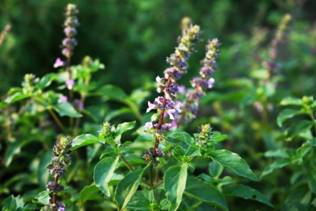
Ocimum sanctum, Holy basil, or tulsi, is anaromatic plant in the family Lamiaceae which is native to the Indian Subcontinent and widespread as a cultivated plant throughout the Southeast Asian tropics. It is an erect, much branched subshrub, 30–60 cm tall with hairy stems and simple opposite green or purple leaves that are strongly scented. Leaves have petioles and are ovate, up to 5 cm long, usually slightly toothed. The leaves of basil have numerous oil glands with aromatic volatile oil. The flowers are purplish in elongate racemes in close whorls.
Important information about the plant (per acre)
| Variety of Plant | Vishu Priya Tulsi,Rama Tulsi,kalaTulsi,Bisva Tulsi,Basil Sweet lemon Tulsi |
| No. of plants | 6 kg/acre |
| Sowing Time | Rainy season |
| Soil | Grows well in Sandy loam soil |
| Irrigation System | Drip Irrigation |
| Produce | Leaves |
| Total Cost of Cultivation |
57,500/- |
| Total Production | 2500 kg for 3 times |
| Market/Buy Back Rates | @Rs.60 per kg. |
| Total Income (Profit) | 1,50,000/- |
| Income per year | 92,500/- |
| Buyers | Ayurvedic Companies, Cosmetic Companies, Pharma Companies, Juice and Gel Exporters/Sunrise Agriland Development & Research Pvt. Ltd. |
Uses:
- Tulsi protects against and reduces stress, enhances stamina and endurance, increases the body’s efficient use of oxygen, boosts the immune system, slows aging, and provides a rich supply of antioxidants and other
- It reduces inflammation, prevents gastric ulcers, protects against radiation, lowers fevers, cholesterol and high blood pressure, enhances periodontal health, displays significant natural antibacterial, antiviral and antifungal activity, improves digestion and absorption of other nutrients, and even repels mosquitoes and other potentially harmful
- Tulsi offers remarkable preventative and curative potential with respect to many degenerative disorders, such as cancer, heart disease, arthritis, diabetes and neurological dementia.
Cultivation conditions
Cultivate in all over India. Mostly Cultivataed In Rainy Season , Avoid Winters for cultivation.
Soil :
Best in sandy loam soil,avoid water logging conditions
Nursery preparation
- Preferable time for nursery preparation is from February to may.
- The seeds are mixed with dry sand in 1:5 ratio and are then spread on the land.
- Cover the seeds with a thin layer of soil.
- Irrigation is to be done after two days with the help of sprinklers.
- After 8-12 days the seed start to develop
- When 4-5 leaves are visible, the nursery is ready, and the plants are to be transfer in the field.
Land Preparation
- After 6 weeks the nursery plants are ready to be sown in the field.
- Plants are planted as 1.5’X1.5’, in holes.
- After this, irrigation with the help of sprinklers is done in every 3 days initially, after this after 7-10 days regularly
Harvesting
- The first cutting is to be made after 90-95 days in proper sunlight.
- The cut is to be made above 15cm above the ground
- After first cutting the regular cutting will take place in every 70-75 days
- After second cutting the third cutting is to be made after 70-75 days
Receipts
2500kg leaves are obtained from three cuttings in a year
 Bed prepared uniformly with tractor
Bed prepared uniformly with tractor Land treatment before tulsi cultivation
Land treatment before tulsi cultivation Drip Laid and Tied properly on each
Drip Laid and Tied properly on each Each bed are covered with punched
Each bed are covered with punched  Cultivation of Tulsi
Cultivation of Tulsi Field of Tulsi Mature Tulsi
Field of Tulsi Mature Tulsi Harvesting of Tulsi
Harvesting of Tulsi

